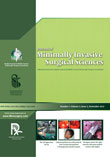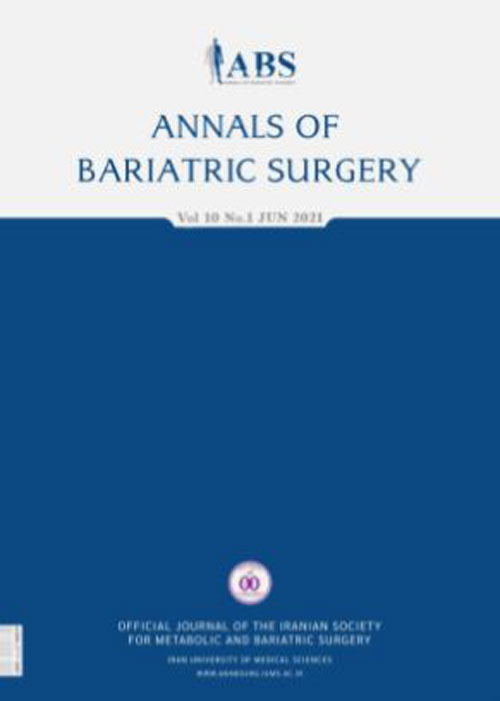فهرست مطالب

Annals of Bariatric Surgery
Volume:5 Issue: 1, Winter 2016
- تاریخ انتشار: 1394/11/25
- تعداد عناوین: 6
-
-
Page 2Context: Clinical therapies and surgical interventions are the acceptable treatments for gastro-esophageal reflux disease (GERD). Referrals for surgery are yet limited, because of disadvantages associated to surgical treatment, including: (a) high rate of mortality; (b) high risk of side effects, especially dysphagia; (c) need for acid-reducing medications after surgery; (d) need for revision surgery; (e) unclear benefit of surgery on the risk of cancer; and (f) differences in the outcomes between a community setting and a tertiary care center. In contrast, surgeons report excellent outcomes after anti-reflux operation..
Evidence Acquisition: A thorough search in literature was performed with predefined keywords to identify relevant articles published from 1975 to January 2015, in order to analyze the complications from the aspect of current surgeons perspective..ResultsOur review showed that: (a) the mortality rate of the surgical procedure is negligible and PPI therapy is also accompanied with mortality; (b) there is a 5% chance of severe dysphagia after anti-reflux operation; (c) postsurgical use of PPI is not an indication of surgical failure, but often represents misuse of the medication; (d) there is a 5% chance of re-operation after surgery, often because of severe dysphagia; (e) reduction in the risk of adenocarcinoma is probable but still controversial; and (f) good results can be achieved in a community setting..ConclusionsA significant number of patients would benefit from surgical therapy to treat their GERD symptoms, but some incorrect beliefs still misguide the indications for the surgical procedure..Keywords: Gastro, Esophageal Reflux, Surgery, Fundoplication, Mortality, Morbidity -
Page 3BackgroundThere is no literature on the administrative chief resident (ACR) in surgery or disparities of this leadership position..ObjectivesThe aim of this study is to examine the rates of perceived female and minority leadership at the resident level..
Patients andMethodsAfter institutional review board (IRB) approval, a pilot survey was sent to surgical residents and faculty at a single university surgical program. The survey was revised based on small group feedback and a specialist in study design. It was then sent to all US surgical residents and program directors, and analyzed using Survey Monkey..ResultsThere was a 10% resident response rate, 22% program director, most from a program with 50% female residents. 71% report no clear ACR policy, 64% believe the position appointed. Half report less than 25% female ACRs, 54% zero minority ACRs. Program directors reported more female ACRs, but similar lack of selection policy. 54% believe ACR receives a stipend. 31% report more than 75% went into academics..ConclusionsAlthough most surgical programs train 50% female residents, residents perceive that fewer than 25% ACRs are female. ACRs in the United States are often receiving a stipend and going into academic practice. Programs should keep diversity in mind in appointing ACR..Keywords: Women in Surgery, Leadership, Residency, Surgical Leadership, Women in Academic Medicine -
Page 4BackgroundLow back pain (LBP) is one of the most common complaints that is reported by all age groups..ObjectiveThis study was aimed to investigate the efficacy of epidural steroid injections (EPSI) related to different volume injections for treatment of acute low back pain with radiculopathy..
Patients andMethodsThe study is consisted of seventy five patients who had acute discogenic pain. Three groups composed namely Group 1, Group 2 and Group 3. All patients were assigned to one of the groups randomly and recevied combination of triamcinolone (80 mg) and bupivacaine (12.5 mg) as a single epidural dose. Volume of 10 mL, 15 mL, and 20 mL epidural injections were used for Group 1, 2 and 3 respectively. The efficacy of treatment was assessed with visual analog scale; VAS (O = no pain, 10 = unbearable pain) straight leg elevation test; SLET (0° = worst, 85° = best), and oswestry disability ındex; ODI (0 to 20%: minimal disability, 80 to 100%: bed bound patients) before and 2 weeks after the epidural steroid injections (EPSI)..ResultsFifty seven 57 (76%) female and 18 (24%) male were entered to the study. Two weeks after the procedure, significant improvement was observed in each group regarding the results of VAS, SLET and ODI. Temporary radicular pain, not required treatment, was reported for 10 patients; 40% of group II and 18 patients; 72% of group III, but not reported in group I (PConclusionsDifferent volumes of EPSI in patients with acute low back pain associated with radiculopathy causes significant pain relief in all groups. There was no superiority between the groups. Temporary radicular pain we encountered can be explained by high volumes..Keywords: Epidural Analgesia, Low Back Pain, Acute -
Page 5BackgroundPetro-clival, clival and spheno-petro-clival tumours are still a neurosurgical challenge. Usually, the classical skull base transpetrous approaches are employed, although they are burdened by an important rate of morbidity, and a very low rate of radical removal is reported..ObjectivesWe present our indications and results with minimally invasive transnasal and transoral approaches..
Patients andMethodsWe present 14 patients affected by petro-clival, clival and spheno-petro-clival meningiomas/chordomas with prevalent extension ventrally to the brainstem; cranial nerves V to XII and vertebra-basilar arterial complex resulted posterior and laterally displaced. Preoperative clinical symptoms were represented by aspecific headache in 6 patients, mild and moderate contralateral hemiparesis in 3 and 2 patients respectively, mild and moderate tetraparesis in 2 and 1 patients respectively and cranial nerves deficit in 11 ones. Preoperative planning considered threeObjectivesto avoid operative and post-operative mortality/morbidity, to achieve satisfactory tumour removal and to avoid tumour regrowth. Anterior approach (transoral in 6 and transsphenoidal in 8 other) was selected for these patients according to postero-lateral approaches complexity due to the anterior-medial position of the tumour in respect of cranial nerves and vascular arteries..ResultsIn no patient radical removal was performed because gross total/subtotal removal had been programmed preoperatively on the basis of tumours extension. Concerning the 4 clival chordomas, gross total in two patients and subtotal removal in the two other ones was performed. Gross total removal was accomplished in the clival meningioma, while subtotal removal was achieved in 5 petro-clival and in 2 spheno-petro-clival meningiomas; partial removal was performed in one spheno-petro-clival and one petro-clival meningioma. No mortality and no neurologic deficits were registered after surgery. Preoperative neurologic deficit improved in the majority of patients..ConclusionsAnterior transoral and transsphenoidal approaches are indicated for clival and spheno-petro-clival region tumours located ventrally to the brainstem and medially to acoustic meatus, to perform a prevalently median tumour debulking; these approaches allowed an extremely low rate of new neurological deficit and a rapid resumption of vital activities, obviously in relation with preoperative clinical status in our patients..Keywords: Transoral Approach, Transsphenoidal Approach, Petro, Clival Tumours, Spheno, Petro, Clival Tumours -
Page 6BackgroundA significant proportion of individuals undergoing cholecystectomy for symptomatic cholelithiasis persist with symptoms even after surgery..ObjectivesThis study was aimed to test our hypothesis that age of presentation and duration of symptoms are the risk factors that predispose to negative symptomatic outcome after cholecystectomy..
Patients andMethods351 patients with diagnosis of symptomatic gallstones admitted to a tertiary care hospital for elective laproscopic cholecystectomy over a period of three years from 2009. They were provided a standard symptom questionnaire to evaluate the symptomatic outcome and to compare the quality of life at interval of one, three and six months after the procedure regarding the presenting symptoms at the time of admission. Out of 351 patients, 51 patients refused to continue participation in the study and were excluded from the study group. The remaining 300 patients were followed till six months after procedure..Results55.66% of patients were highly satisfied after cholecystectomy with regard to alleviation of preoperative symptoms, while 34.33% of patients were satisfied with the treatment. A minority of 8.6% of patients perceived no change with regard to preoperative symptoms, while 1.3% of them had worsening of symptoms..ConclusionsWe conclude that management of gall bladder stone disease should be tailored precisely with respect to the quality of life index, with increased emphasis on early detection and treatment as well as increased emphasis on counseling in an elderly cohort after considering the prognosis after cholecystectomy differentially..Keywords: Cholecystectomy, Dyspepsia, Abdominal Pain, Jaundice


